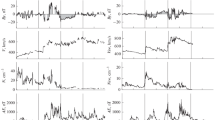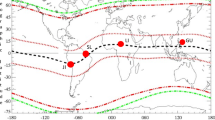Abstract
The injection of energy into the Earth’s magnetosphere during geomagnetic storms and substorms has a direct impact on the ionosphere in the auroral and sub-auroral regions. This influence can be observed through phenomena such as the expansion of the auroral oval, and fluctuations in plasma density and the intensity of the field-aligned current (FAC) system. Changes in the geomagnetic environment significantly affect the main ionospheric trough (MIT) and field-aligned currents (FACs). In this study, we analysed two geomagnetic storms of different origins—October 2015 and September 2017 that occurred during solar cycle 24. Both storms were characterised by two minima of the Dst index and classified as two-step storms. In this work, we investigate the evolution of FACs density, the displacement of MIT and FACs during the development of geomagnetic storms, and we quest for the relationship between field-aligned currents and the main ionospheric trough. We noticed a connection between the positions of the main ionospheric trough minima and the Dst index, found cases especially during the main and recovery phase of the storms when FACs increase after leaving the ionospheric trough, and observed the predominance of downward currents in the area of the MIT which suggest their influence on the formation of this region of depleted plasma density.






















Similar content being viewed by others
References
Abdu M (2005) Equatorial ionosphere–thermosphere system: electrodynamics and irregularities. Adv Space Res 35(5):771–787. https://doi.org/10.1016/j.asr.2005.03.150
Baumjohann W, Haerendel G (1985) Magnetospheric convection observed between 0600 and 2100 LT: solar wind and IMF dependence. J Geophys Res Space Phys 90:6370–6378. https://doi.org/10.1029/JA090iA07p06370
Block L, Fälthammar C (1968) Effects of field-aligned currents on the structure of the ionosphere. J Geophys Res 73(15):4807–4812. https://doi.org/10.1029/JA073i015p04807
Borovsky J, Denton M (2006) Differences between CME-driven storms and CIR-driven storms. J Geophys Res 111(A7). https://doi.org/10.1029/2005JA011447
Collis P, Häggström I (1988) Plasma convection and auroral precipitation processes associated with the main ionospheric trough at high latitudes. J Atmos Terr Phys 50:389–404. https://doi.org/10.1016/0021-9169(88)90024-4
Cowley SW (2000) Magnetosphere-ionosphere interactions: a tutorial review. Magnetos Curr Syst 118:91–106. https://doi.org/10.1029/GM118p0091
Cran-McGreehin AP, Wright AN, Hood AW (2007) Ionospheric depletion in auroral downward currents. J Geophys Res 112:A10309. https://doi.org/10.1029/2007JA012350
Deminov M, Karpachev A, Annakuliev S, Afonin V, Smilauer Y (1996) Dynamics of the ionization troughs in the night-time subauroral F-region during geomagnetic storms. Adv Space Res 17:141–145. https://doi.org/10.1016/0273-1177(95)00706-K
Dorman L, Tassev Y, Velinov P, Mishev A, Tomova D, Mateev L (2019) Investigation of exceptional solar activity in September 2017: GLE 72 and unusual Forbush decrease in GCR. J Phys Conf Ser 1181:012070. https://doi.org/10.1088/1742-6596/1181/1/012070
Dungey JW (1961) Interplanetary magnetic field and the auroral zones. Phys Rev Lett 6:47–48. https://doi.org/10.1103/PhysRevLett.6.47
Echer E, Gonzalez W, Alves M (2006) On the geomagnetic effects of solar wind interplanetary magnetic structures. Space Weather 4:S06001. https://doi.org/10.1029/2005SW000200
Forsyth C, Shortt M, Coxon J, Rae I, Freeman M, Kalmoni N et al (2018) Seasonal and temporal variations of field-aligned currents and ground magnetic deflections during substorms. J Geophys Res Space Physics 123:2696–2713. https://doi.org/10.1002/2017JA025136
Ganushkina N, Liemohn M, Dubyagin S (2018) Current systems in the Earth’s magnetosphere. Rev Geophys 56:309–332. https://doi.org/10.1002/2017RG000590
Gao C, ** S, Yuan L (2020) Ionospheric responses to the june 2015 geomagnetic storm from ground and LEO GNSS observations. Remote Sensing 12(14):2200. https://doi.org/10.3390/rs12142200
Hashimoto KK, Kikuchi T, Tomizawa I et al (2020) Penetration electric fields observed at middle and low latitudes during the 22 June 2015 geomagnetic storm. Earth Planets Space 72:71. https://doi.org/10.1186/s40623-020-01196-0
Iijima T, Potemra TA (1976) The amplitude distribution of field-aligned currents at northern high latitudes observed by triad. J Geophys Res 81:2165
Iijima T, Potemra TA (1978) Large-scale characteristics of field-aligned currents associated with substorms. J Geophys Res 83:599
Karpachev AT (2003) The dependence of the main ionospheric trough shape on longitude, altitude, season, local time, and solar and magnetic activity. Geomag Aeron 43(2):239–251
Karpachev AT (2019) Variations in the winter troughs’ position with local time, longitude, and solar activity in the Northern and Southern Hemispheres. J Geophys Res Space Physics 124:8039–8055. https://doi.org/10.1029/2019JA026631
Knudsen W (1974) Magnetospheric convection and the high-latitude F 2 ionosphere. J Geophys Res 79(7):1046–1055. https://doi.org/10.1029/JA079i007p01046
Kramer H (2002) Observation of the earth and its environment: survey of missions and sensors. DMSP (Defense Meteorological Satellite Program) Block 5D, https://directory.eoportal.org/web/eoportal/-/dmsp
Krinberg IA, Tashchilin AV (1984) Ionosphere and plasmasphere (in Russian), Nauka, 189. USSR, Moscow
Liu Y, **ong C, Wan X, Lai Y, Wang Y, Yu X, Ou M et al (2021) Instability mechanisms for the F-region plasma irregularities inside the midlatitude ionospheric trough: swarm observations. Space Weather 19(7):e2021SW002785. https://doi.org/10.1029/2021SW002785
Lukianova R (2020) Swarm field-aligned currents during a severe magnetic storm of September 2017. Ann Geophys 38(1):191–206. https://doi.org/10.5194/angeo-38-191-2020
Lyatsky VB, Mal’tsev P (1981) Origin of the mid-latitude trough and of the polar void in the ionospheric density distribution. Geomag Aeron 21:127–128
Matamba T, Habarulema J (2018) Ionospheric responses to CME- and CIR-driven geomagnetic storms along 30°E–40°E over the African sector from 2001 to 2015. Space Weather 16:538–556. https://doi.org/10.1029/2017SW001754
Matyjasiak B, Przepiórka D, Rothkaehl H (2016) Seasonal variations of mid-latitude ionospheric trough structure observed with DEMETER and COSMIC. Acta Geophys 64:2734–2747. https://doi.org/10.1515/acgeo-2016-0102
Navia CE, de Oliveira MN, Augusto CRA (2018) The highest geomagnetic storms of the solar cycle observed at ground level. INTECH. https://doi.org/10.5772/intechopen.75688
Nilsson H, Sergienko T, Ebihara Y, Yamauchi M (2005) Quiet-time mid-latitude trough: Influence of convection, field-aligned currents and proton precipitation. Ann Geophys. https://doi.org/10.5194/angeo-23-3277-2005
Ohtani S, Wing S, Merkin VG, Higuchi T (2014) Solar cycle dependence of nightside field-aligned currents: effects of dayside ionospheric conductivity on the solar wind-magnetosphere-ionosphere coupling. J Geophys Res Space Physics 119:322–334. https://doi.org/10.1002/2013JA019410
Oliveira D (2014) Ionosphere-magnetosphere coupling and field-aligned currents. Rev Bras de Ensino de F´ısica 36(1):4. https://doi.org/10.1590/S1806-11172014000100005
Pitout F, Marchaudon A, Blelly PL, Bai X, Forme F, Buchert SC, Lorentzen DA et al (2015) Swarm and ESR observations of the ionospheric response to a field-aligned current system in the high-latitude midnight sector. Geophys Res Lett 42(11):4270–4279. https://doi.org/10.1002/2015GL064231
Prölss G, Brace L, Mayr H, Carignan G, Killeen T, Klobuchar J (1991) Ionospheric storm effects at subauroral latitudes: a case study. J Geophys Res 96:1275–1288. https://doi.org/10.1029/90JA02326
Redmon R (2017) New DMSP database of precipitating auroral electrons and ions. JGR Space Physics 122(8):9056–9067. https://doi.org/10.1002/2016JA023339
Rich F (1994) Users Guide for the Topside Ionospheric Plasma Monitor (SSIES, SSIES-2 and SSIES-3) on Spacecraft of the Defense Meteorological Satellite Program, Volume 1: Technical Description. Environ Res Pap 1151 77
Ritter P, Lühr H, Rauberg J (2013) Determining field-aligned currents with the Swarm constellation mission. Earth Planet Sp 65:1285–1294. https://doi.org/10.5047/eps.2013.09.006
Rodger A, Moffett R, Quegan S (1992) The role of ion drift in the formation of ionisation troughs in the mid- and high-latitude ionosphere—A review. J Atmos Terr Phys 54:1–30. https://doi.org/10.1016/0021-9169(92)90082-V
Rodger A (2008) The Mid-latitude trough, revisited. In P. M. Kintner, A. J. Coster, T. Fuller-Rowell, A. J. Mannucci, M. Mendillo, & R. Heelis (Eds.), Midlatitude ionospheric dynamics and disturbances, Geophysical Monograph Series (Vol. 181, pp. 25–33). Washington, DCAGU, https://doi.org/10.1029/181gm04
Russell A, Karlsson T, Wright A (2015) Magnetospheric signatures of ionospheric density cavities observed by Cluster. J Geophys Res Space Phys 120(3):1876–1887. https://doi.org/10.1002/2014JA020937
Sazykin S, Wolf R, Spiro R, Fejer B et al (2002) The effect of longitudinal conductance variations on the ionospheric prompt penetration electric fields. 34th COSPAR Scientific Assembly.
Schunk RW, Raitt WJ, Banks PM (1975) Effect of electric fields on the daytime high-latitude E- and F-regions. J Geophys Res 80:3121–3130
Sugiura M (1964) Hourly values of equatorial Dst for the IGY. Ann Int Geophys Year 35:9–35
Tassev Y, Velinov P, Mateev L, Tomova D (2018) Analysis of extreme solar activity in early September 2017: G4-severe geomagnetic storm (07–0809) and GLE72 (1009) in solar minimum. Comptes Rendus De L’academie Bulg Des Sci 70(10):1437–1444
Tsurutani BT, Gonzalez WD, Gonzalez ALC, Guarnieri FL, Gopalswamy N, Grande M, Vasyliunas V et al (2006) Corotating solar wind streams and recurrent geomagnetic activity: a review. J Geophys Res 111(A7):3–7, 20. https://doi.org/10.1029/2005JA011273
Voiculescu M, Nygrén T (2007) IMF effect on ionospheric trough occurrence at equinoxes. Adv Space Res 40:1935–1940
Voiculescu M, Nygren T, Aikio AT, Vanhamaki V, Pierrard V (2016) Post-midnight ionospheric troughs in summer at high latitudes. J Geophys Res Space Physics 121(12):12–17. https://doi.org/10.1002/2016JA023360
Wang H, Lühr H, Ridley A, Huang T (2014) The spatial distribution of region 2 field-aligned currents relative to subauroral polarization stream. Ann Geophys 32:533–542. https://doi.org/10.5194/angeo-32-533-2014
Werner A, Yordanova E, Dimmock A, Temmer M (2019) Modeling the multiple CME interaction event on 6–9 September 2017 with WSA-ENLIL+Cone. Space Weather 17(2):357–369. https://doi.org/10.1029/2018SW001993
**ong C, Stolle C, Alken P et al (2020) Relationship between large-scale ionospheric field-aligned currents and electron/ion precipitations: DMSP observations. Earth Planets Space 72:147. https://doi.org/10.1186/s40623-020-01286-z
Yang N, Le H, Liu L (2015) Statistical analysis of ionospheric mid-latitude trough over the northern hemisphere derived from GPS total electron content data. Earth Planet Sp 67:196. https://doi.org/10.1186/s40623-015-0365-1
Yang N, Le H, Liu L (2016) Statistical analysis of the mid-latitude trough position during different categories of magnetic storms and different storm intensities. Earth Planets Space 68:171. https://doi.org/10.1186/s40623-016-0554-6
Zhang B-C, Kamide Y, Liu R-Y (2003) Response of electron temperature to field-aligned current carried by thermal electrons: a model. J Geophys Res 108:1169. https://doi.org/10.1029/2002JA009532,A5
Zou S, Moldwin M, Nicolls M, Ridley A, Coster A, Yizengaw E, Lyons L, Donovan E (2013) Electrodynamics of the high-latitude trough: Its relationship with convection flows and field-aligned currents. J Geophys Res Space Physics 118:2565–2572. https://doi.org/10.1002/jgra.50120
Acknowledgements
We acknowledge the Swarm Science Team for providing the Level 2 data, the Swarm visualisation tool (https://vires.services/), the Virtual Research Environment ("VRE"), and the PRISM product.
The Dst index used in this paper was provided by the WDC for Geomagnetism, Kyoto (http://wdc.kugi.kyoto-u.ac.jp/wdc/Sec3.html).
Data from the DMSP satellites are kindly provided by Patricia Doherty and were downloaded from the CEDAR Madrigal Database (http://cedar.openmadrigal.org/).
Author information
Authors and Affiliations
Corresponding author
Ethics declarations
Conflict of interest
The authors declare no competing interests related to the research, content, or findings presented in this manuscript. This work was conducted with the utmost scientific integrity and without any financial, personal, or professional biases that could potentially influence the interpretation or reporting of the results. This statement is intended to ensure transparency and maintain the credibility of the research conducted and reported herein.
Additional information
Edited by Prof. Andrzej Krankowski (ASSOCIATE EDITOR) / Prof. Theodore Karacostas (CO-EDITOR-IN-CHIEF).
Rights and permissions
Springer Nature or its licensor (e.g. a society or other partner) holds exclusive rights to this article under a publishing agreement with the author(s) or other rightsholder(s); author self-archiving of the accepted manuscript version of this article is solely governed by the terms of such publishing agreement and applicable law.
About this article
Cite this article
Chuchra-Konrad, A., Matyjasiak, B., Przepiórka-Skup, D. et al. Main ionospheric trough and field-aligned currents’ responses to the geomagnetic storms in October 2015 and September 2017. Acta Geophys. (2024). https://doi.org/10.1007/s11600-024-01304-8
Received:
Accepted:
Published:
DOI: https://doi.org/10.1007/s11600-024-01304-8




